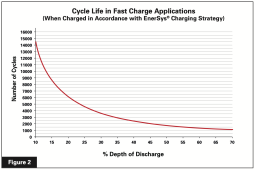It depends on how manufacturers define it. There is no standard.
e.g. often for a LiFePO₄ BMS a cycle count occurs after a combined discharge of 80% of the the rated capacity, unless the manufacturer provides a specific DOD value. That's how my LiFePO₄ battery BMSs calculate cycle count.
On the other hand my SLA batteries have this chart showing the cycle count vs DOD using the specific charge and discharge protocols. It shows a typical hyperbolic-like curve:
View attachment 154523
As I said earlier, claimed cycle counts need to be accompanied with the specific protocols they apply to.
They really are only a general guide.
All I know is, based on the chart above, my SLA will last a long time doing what they are currently doing, with a daily DOD of no more than 5-10%, mostly kept at float and ready to provide supplemental outage backup power if needed. At $US 6.5c/Wh second hand, they are a really good option for this job. I see little point wasting money on LiFePO₄ at US$0.32/Wh to sit there doing SFA most of the time. Instead my LiFePO₄ is sized to deeply cycle each day.





